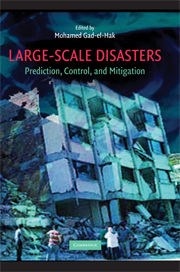Crossref Citations
This Book has been
cited by the following publications. This list is generated based on data provided by Crossref.
Gad-El-Hak, M.
2009.
The art and science of large-scale disasters.
Bulletin of the Polish Academy of Sciences: Technical Sciences,
Vol. 57,
Issue. 1,
p.
3.
Ruwanpura, J.
Wickaramaratne, S.
Braun, A.
and
Wirasinghe, S. C.
2009.
Planning and modelling for mitigation of tsunami impacts.
Civil Engineering and Environmental Systems,
Vol. 26,
Issue. 2,
p.
195.
Gad-el-Hak, Mohamed
2010.
Facets and Scope of Large-Scale Disasters.
Natural Hazards Review,
Vol. 11,
Issue. 1,
p.
1.
Mohamad, Mohamad Ibrahim
Nekooie, Mohammad Ali
Ismail, Zulhilmi
and
Taherkhani, Roohollah
2012.
Amphibious Urbanization as a Sustainable Flood Mitigation Strategy in South-East Asia.
Advanced Materials Research,
Vol. 622-623,
Issue. ,
p.
1696.
Wickramaratne, Sanjeewa
Ruwanpura, Janaka
Ranasinghe, Upul
Walawe‐Durage, Samanthi
Adikariwattage, Varuna
and
Wirasinghe, S.C.
2012.
Ranking of natural disasters in Sri Lanka for mitigation planning.
International Journal of Disaster Resilience in the Built Environment,
Vol. 3,
Issue. 2,
p.
115.
Miao, Xin
Banister, David
and
Tang, Yanhong
2013.
Embedding resilience in emergency resource management to cope with natural hazards.
Natural Hazards,
Vol. 69,
Issue. 3,
p.
1389.
Schieb, Pierre-Alain
2013.
Encyclopedia of Natural Hazards.
p.
242.
Shi, Peijun
and
Liu, Yanhua
2013.
Integrated Risk Governance.
p.
187.
Bastos, Maria Aparecida Garcia
Campos, Vania Barcellos Gouvêa
and
Bandeira, Renata Albergaria de Mello
2014.
Logistic Processes in a Post-disaster Relief Operation.
Procedia - Social and Behavioral Sciences,
Vol. 111,
Issue. ,
p.
1175.
Chou, Jui-Sheng
and
Lee, Chen-Ming
2014.
Integrating the geographic information system and predictive data mining techniques to model effects of compound disasters in Taipei.
Natural Hazards,
Vol. 70,
Issue. 2,
p.
1385.
2014.
CrowdHelp: M-Health application for emergency response improvement through crowdsourced and sensor-detected information.
p.
1.
Xiaohong Yang
Xie, Zhong
Xiangang Luo
and
Chen, Zhanlong
2015.
Building damage assessment approach based on seismic spatial information grid.
p.
1.
Besaleva, Liliya I.
and
Weaver, Alfred C.
2016.
Applications of Social Networks and Crowdsourcing for Disaster Management Improvement.
Computer,
Vol. 49,
Issue. 5,
p.
47.
Gaitán, Carlos F.
2016.
Effects of variance adjustment techniques and time-invariant transfer functions on heat wave duration indices and other metrics derived from downscaled time-series. Study case: Montreal, Canada.
Natural Hazards,
Nekooie, Mohammad Ali
Mohamad, Mohamad Ibrahim
and
Ismail, Zulhilmi
2017.
Drag coefficient for amphibious house.
Urban Water Journal,
Vol. 14,
Issue. 10,
p.
1045.
Shi, Peijun
2019.
Disaster Risk Science.
p.
1.
Shi, Peijun
2019.
Disaster Risk Science.
p.
49.
Jana, R. K.
Chandra, Chandra Prakash
and
Tiwari, Aviral Kumar
2019.
Humanitarian aid delivery decisions during the early recovery phase of disaster using a discrete choice multi-attribute value method.
Annals of Operations Research,
Vol. 283,
Issue. 1-2,
p.
1211.
2019.
Risk Assessment.
p.
17.
Shi, Peijun
2019.
Disaster Risk Science.
p.
1.



